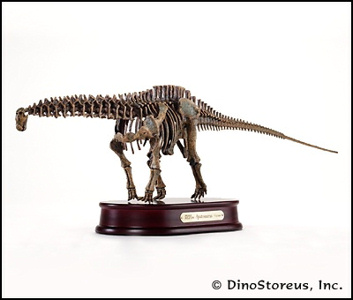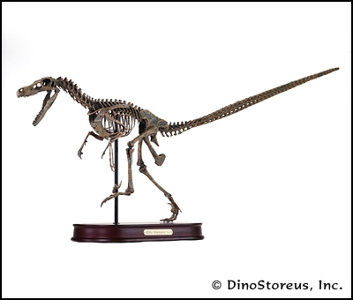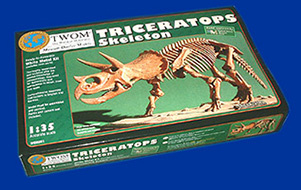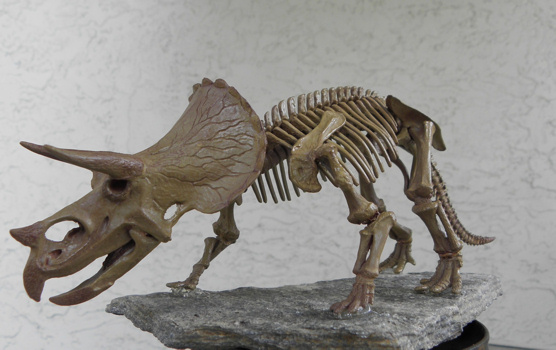(my dance with dinosaurs)
page 3
SOME HITS AND MISSED OPPORTUNITIES TO COME?
For the next few years it seemed
that the new Millennium was not
going to be heavy on dinosaur skeleton models. There have been a
lot of wooden skeletal models that pretty much stay in the category of
toys. I have been given a few as gifts and while they are fun to
assemble and they give the impression of a skeleton, they are not skeletons; no bones about
it. A friend surprised me with a Velociraptor kit
that he had scaled up and cut in 3/8" aluminum plate with a shielded
arc laser. It looks really nice. It is attached to a rock
base and resides in my yard, hopefully playing some role in keeping
raccoons from my fishpond. One Christmas I received a kit
that recreated a fossil
digging experience, featuring a Triceratops. It was fun chipping
away at the plaster to reveal the skeleton in profile and it made a
nice wall hanging, but it was still pretty much in the category of
toys, albeit an educational toy. I still didn't
quite have the
Triceratops I wanted. At another Christmas I
was given a "Tiny Perfect Dinosaur" Velociraptor kit and had to admit
that after being painted to look like a fossil, it was fairly
nice. I later bought the Hypacrosaurus in the same series, but
most of the others just didn't seem to have much detail or look like
much more than toys and in any case, these were all made back in the
1990's.

YARD RAPTOR UNKNOWN SCALE 24" (61 cm)
TINY PERFECT VELOCIRAPTOR 12.5' 931 CM)
TINY PERFECT HYPACROSAURUS 11.5" (29 cm)
Speaking of toys, I
frequently
saw a Tyrannosaurus skeleton kit on Ebay, designed by an Italian
paleontologist named Stefano Piccini and produced by a company called
Geoworld. The kit was fairly inexpensive and very large, over
three feet (a meter) long, and was apparently
designed to stand up to children repeatedly putting it together an
taking it apart. It was made of a resin/hard
plastic substance and some of the pictures looked fairly nice, but the
skull was a bit strange, with the lower jaw positioned so that it
articulated with the inside of the skull rather than at the usual point
of articulation with the quadrate.
There was also a
similar model of a Diplodocus skeleton. It is often hard to tell
from the packaging, but there may be several different companies
selling the same kit. I have also seen a model of a
Brachiosaurus. Each of these models is huge, with the
Tyrannosaurus and Diplodocus around three feet (a meter) in length and
the Brachiosaurus is a meter tall!
In any case, I never felt compelled to
take up that much shelf space with these kits when I already had
a Tyrannosaurus and an
Apatosaurus.



GEOWORLD TYRANNOSAURUS ~1/10 DIPLODOCUS BRACHIOSAURUS
During this time the Healthstones
line of dinosaur
skeletons also appeared. How they got that name is beyond me, but
the original sculpts were apparently done by some fast-working Japanese
and then produced in China. Almost overnight there was an
incredible profusion of complete skeletons and attractively mounted
skulls available. I couldn't decide which to buy and rapidly
developed fossil fatigue thinking about it. That wasn't the only
thing holding me back, of course. Somehow it didn't seem
right to take a skeleton kit out of a box and put it on a shelf without
having assembled and painted it myself. I also began to look at
them more closely and noticed that there was often a certain heaviness
in places where bones were supposed to be delicate. It also
seemed that their rather thickly applied faux-fossil finish hid a lot
of uncertainty in detail and their appeal to me rapidly waned. I
did receive a Healthstones Triceratops skull as a gift and it is nicely
made, as are many of their other skulls. I know that some
collectors prefer to buy their models already built and painted, but
the ready-to-display nature of these models just never grabbed
me. Also, given their prices of $250 to $350 each, I never
felt much urgency to acquire them. Apparently they have now
ceased production on many of them. In a few years I will probably
decide that I have to have
them and wonder why I didn't get them now when they were readily
available. Well, that's how the soul of a collector works.



HEALTHSTONES APATOSAURUS, ALLOSAURUS, AND VELOCIRAPTOR
One bright spot did shine on me in
2004. I read in Prehistoric
Times about a new Triceratops skeleton made by a Swiss company, The
World of Miniatures. While they mostly make military models, they
produced a beautiful 1/35 scale Triceratops at a pretty decent price
and I immediately bought it. In a familiar pattern, their
original stated plan was
to make more dinosaur skeletons, but they have never offered anything
else. Still, the kit seems beautiful. There is a lot of
texture on the bones, which are mostly cast in white metal with a resin
head. It definitely satisfied my longstanding craving for a
Triceratops skeleton and while it has been in my closet for a long
time, I actually look forward to building it fairly
soon.

THE WORLD OF MINIATURES TRICERATOPS
I had some extra time over the past
week, so I actually got down to business and put this kit
together! I hadn't had much prior experience with metal kits, so
working on this was a bit exasperating at times. The instructions
were fun, being in both Deutsch and English. They were pretty
helpful, but not entirely correct in either language. The
instructions sugested using two part expoxy and that probably would
have been a good idea. My closest craft store only had the type
that required mixing a large amount at one time, and there are a lot of
places in the instructions that require that an assembly be
firmly set before going to the next step, making for an inefficient use
of the adhesive. I decided to try using a cement that claimed to
be good for metal, and once cured it was supposed to be hard enough to
paint. It never worked. The bonds remained slightly
flexible even after three days and when handled would frequently come
apart. I ended up using superglue, which was suggested as an
alternative. That worked fairly well and seemed to give a stable
bond, but
when stressed, the joints had a tendency to pop apart. This was
exacerbated by the weight of the model. Metal pieces are very
heavy. It was a good idea to save weight by casting the skull in
resin, even if the
horns and mandible were metal. Otherwise, the model would
probably end up resting on its beak. Even with that
weight-saving measure, it seemed apparent that cement alone would not
be adequate to hold the skull on the end of the neck. I was
similarly concerned that the tail, designed to be held off the ground,
would not be likely to remain in its socket. The instructions
suggested drilling a hole in the the back of the skull for a
strengthening wire as well as making a deeper hole in the back of the
spine to accept the tab on the tail. I ended up using pins
to support both joints as well as pinning one of the shoulders
together. Then I attached the whole thing to a rock base before
anything else could shift. Maybe I could have avoided the hassle
by driving the extra distance to Home Depot to get a more convenient
package of two-part expoxy, although I am not all that convinced that
anything actually not involving a blowtorch bonds metal particularly
well. Whatever the challenges involved in putting it together,
the model is beautiful. The bones are very finely textured and
while it is not as action-oriented as the Kaiyodo kit, it has a nicely
dynamic forward striding stance.







THE GHOSTS OF ANTS